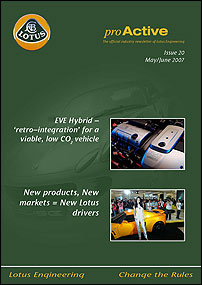 Any good engineer or designer needs a handy reference guide of dimensional data for common fasteners. While my favorite is the hardbound book offered by Kanebridge, ACF Components is offering a similar guide in a free, downloadable PDF. They do require you to fill out a form with your contact info, but it’s a small price to pay for a good reference manual.
Any good engineer or designer needs a handy reference guide of dimensional data for common fasteners. While my favorite is the hardbound book offered by Kanebridge, ACF Components is offering a similar guide in a free, downloadable PDF. They do require you to fill out a form with your contact info, but it’s a small price to pay for a good reference manual.
Author Archives: Matt
SolidWorks 2008 officially released
SolidWorks 2008 has escaped beta testing and been released to production, featuring over 250 enhancements and a new, reduced-clutter user interface. There’s a cool built-in tolerance analysis tool, among other new features. Read more here (via Desktop Engineering).
New issue of Lotus proActive newsletter
 The May/June 2007 issue of the free Lotus proActive newsletter is available for download here. This issue covers various news from Lotus and the automotive industry in general, the advantages of reducing vehicle structure weight (and how to go about it), the robot-piloted Elise used in an upcoming DARPA competition, CO2 emissions reduction.
The May/June 2007 issue of the free Lotus proActive newsletter is available for download here. This issue covers various news from Lotus and the automotive industry in general, the advantages of reducing vehicle structure weight (and how to go about it), the robot-piloted Elise used in an upcoming DARPA competition, CO2 emissions reduction.
One thing about their chassis design though, is that while using various cold joining techniques such as adhesive may be nice from a design perspective as you don’t have Heat Affected Zones of decreased strength around welded joints, this design approach fails to address how the vehicle may someday be repaired if necessary. Designing around Heat Affected Joints may lead to increased overall weight of the vehicle, but the alternative leaves little ability to rework a damaged chassis. The result can be viewed with Lotus’ current sports car, the Elise. There exists no approved method for repairing an Elise chassis, as it’s created entirely through cold joining techniques. While it is technologically feasible to repair a chassis by adding sufficient reinforcement to compensate for Heat Affected Joints necessitated by common repair techniques (ie, welding), there is no set formula for how to do this. The result is if the chassis suffers any damage whatsoever, replacement is the only option. This trend may be of little importance to the automobile manufacturer, as it’s a cost incurred by the customer, not them. However, if this attitude continues then increasing insurance costs will lead to savvy consumers avoiding cars designed in this manner. A good design will strike a balance not just in manufacturing and performance, but over the expected life of the product. A reality of that, for a car, is that the vehicle may experience a minor accident such that the car should not need to be totaled. Again, as an example, a minor accident in an Elise that impacts one of the wheels can often deform the suspension mounting points on the chassis – which then necessitates replacement of the entire chassis! Keep this in mind while reading about all the advantages of Lotus’ VVT vehicle architecture – it may sound good, but how will it be repaired? This is a good lesson for engineering design in general; we often get tunnel-vision and fail to consider the larger picture of how the product will actually be used (and abused!).
Run Pro/E or SolidWorks on a Mac?
Mac fans no doubt know about Bootcamp, a way to dual-boot your Intel-based Mac into either OS-X or Windows. It generally works fine from what I’ve heard, but who wants to dual-boot? Well, the latest version of Parallels Desktop not only allows you to run Windows applications from the OS-X environment, but finally supports OpenGL. This means that, in theory, you’d be able to launch SolidWorks (or any other cad system) just like you would any other application. I expect there’ll be some performance hit, but likely minor. Before I rush out and spend $80 to get this ability, though, I’m going to see what Apple has to say about its next version of OS-X, Leopard, at their developers’ conference next week. There have been rumors that bootcamp will become more tightly integrated with the OS, perhaps making Parallels Desktop unnecessary.